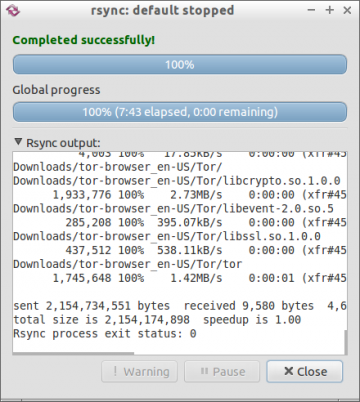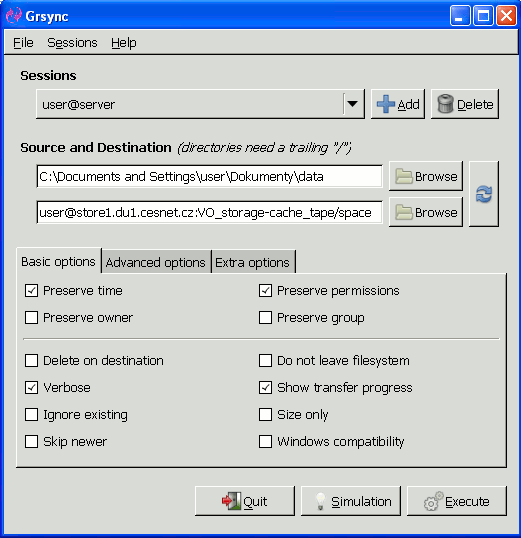

It is used to create filesystem snapshots in two modes: RSYNC mode where snapshots are taken using rsync+hardlinks on all systems and BTRFS mode where snapshots are taken using the in-built features only on BTRFS systems. Timeshift is an open-source powerful backup and system restore tool for Linux that requires little setup.
#Grsync vs arrsync install
To install Grsync on your system, simply run the following command: $ sudo apt install grsync Grsync – Backup and File Synchronization Tool

It comes with an efficient interface and supports the storage of different sessions (you can create and switch between sessions). It currently supports only a limited set of the most important rsync features, however, it can be used effectively to synchronize directories, files, and make backups. Grsync is an open-source simple, great, and easy to use graphical user interface for the popular rsync command-line tool. This requires you to have snapd package installed on your system. To install Déjà Dup in Ubuntu and Linux Mint, open a terminal window and run the following command: $ sudo apt install deja-dupĪlternatively, you can also install it as a snap as follows. It also features incremental backups that allow you to restore from any particular backup, schedules regular backups, and integrates well with GNOME desktop environment. It securely encrypts data for safe transactions and compresses data for faster transmission. It supports local, off-site (or remote), or cloud backup locations such as Google drive. It uses duplicity (encrypted bandwidth-efficient backup using the rsync algorithm) as the backend. Déjà Dupĭéjà Dup is an open-source simple yet powerful personal backup tool that makes backup incredibly easy. These Linux backup tools are also installable and work on Ubuntu flavors such as Lubuntu, Kubuntu, and Xubuntu and other derivatives such as elementary OS, Zorin OS, and more.

Then the new hard link should present a smaller size then the old hard link.In this guide, we review the best graphical user interface backup tools for Ubuntu and Linux Mint operating systems. When I delete data in that file, it becomes smaller. So a hard link presents the same size as the file it points to. Yes, I found the answer to the first question: there’s a file excluded in the settings, and its size is 2.3 Gb, which makes up for the difference. Thanx sanmig, I only read your reply just now. Only the total size of two (or more) incremental backups will be smaller than the sum of both (or all), depending on the difference in the data files.īut when you create a new backup folder (in the Settings) and take a backup the source file will be copied again into the new back up folder, requiring the same space there, too. Each hard link is a perfect pointer to one and the same file, not ‘just a link’ … think of something more bidirectionally, similar to a mirror. unixlinux/) the incremental (hard) link presents the same file size as the first file to the OS, it is the same file. Yes, the backups are incremental, but because of using Rsync (hard links, see. Otherwise original and backup must have the same size! my foxclone test images require root permission to access - unfortunately Nemo offers “Copy” but fails to do it as standard user …). In my case, when using B.I.T as normal user, there are warnings and files missing because of deficient permissions (e.g. I can not explain but suspect not all files were backed up: Compare them using Nemo and check the log (menu "View"). The first is the difference between 5.5 and 3.2 GB. Since Back in Time snapshots are incremental, I would expect the first snapshot to be larger than the second? So if you restore files without Back in Time, permissions could get lost. If the backup drive does not support permissions Back in Time will restore permissions from fileinfo.bz2. They can be browsed with a normal file-browser or in Terminal which makes it possible to restore files even without Back in Time.įiles ownership, group and permissions are stored in a separate compressed plain text file ( fileinfo.bz2). Same here, original files are rw-, snapshots are r-, to protect them I guess.
#Grsync vs arrsync full
I think the read only is an attempt to protect the backup’s integrity, as I haven’t seen data files with rw in the backup?Īlso all attributes are stored in an extra file so one could use a NTFS destination for the backup, with full rsync it requires the ext format. rw what was -r-, it would be useless otherwise. As you wrote, at restore all the permissions are restored, e.g.


 0 kommentar(er)
0 kommentar(er)
